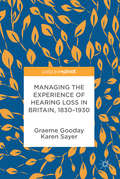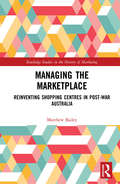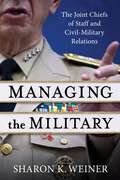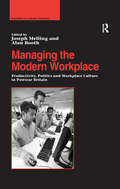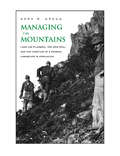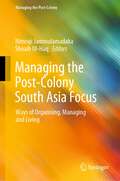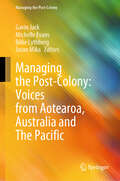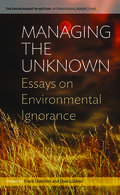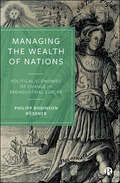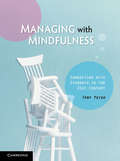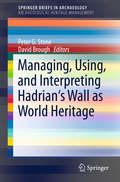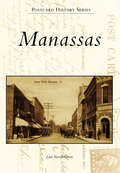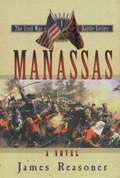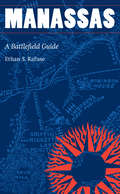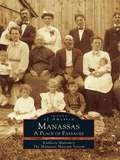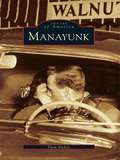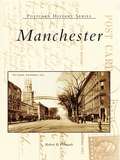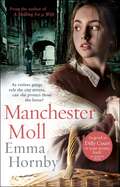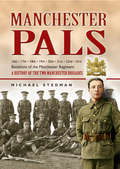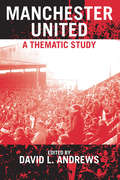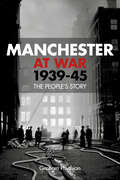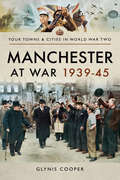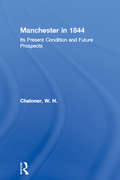- Table View
- List View
Managing the Experience of Hearing Loss in Britain, 1830–1930
by Graeme Gooday Karen SayerThis book looks at how hearing loss among adults was experienced, viewed and treated in Britain before the National Health Service. We explore the changing status of ‘hard of hearing’ people during the nineteenth century as categorized among diverse and changing categories of ‘deafness’. Then we explore the advisory literature for managing hearing loss, and techniques for communicating with hearing aids, lip-reading and correspondence networks. From surveying the commercial selling and daily use of hearing aids, we see how adverse developments in eugenics prompted otologists to focus primarily on the prevention of deafness. The final chapter shows how hearing loss among First World War combatants prompted hearing specialists to take a more supportive approach, while it fell to the National Institute for the Deaf, formed in 1924, to defend hard of hearing people against unscrupulous hearing aid vendors. This book is suitable for both academic audiences and the general reading public. All royalties from sale of this book will be given to Action on Hearing Loss and the National Deaf Children’s Society.
Managing the Marketplace: Reinventing Shopping Centres in Post-War Australia (Routledge Studies in the History of Marketing)
by Matthew BaileyThis book charts the history of Australian retail developments as well as examining the social and cultural dimensions of shopping in Australia. In the second half of the twentieth century, the shopping centre spread from America around the world. Australia was a very early adopter, and produced a unique shopping centre model. Situating Australian retail developments within a broader international and historical context, Managing the Marketplace demonstrates the ways that local conditions shape global retail forms. Knowledge transfer from Europe and America to Australia was a consistent feature of the Australian retail industry across the twentieth century. By critically examining the strengths and weaknesses of Australian retail firms’ strategies across time, and drawing on the voices of both business elites and ordinary people, the book not only unearths the forgotten stories of Australian retail, it offers new insights into the opportunities and challenges that confront the sector today, both nationally and internationally. This book will be of interest to all scholars and practitioners of retail, marketing, business history and economic geography, as well as social and cultural history.
Managing the Military: The Joint Chiefs of Staff and Civil-Military Relations
by Sharon K. WeinerThe chairman of the Joint Chiefs of Staff (JCS)—a senior group of officers who lead the Army, Navy, Air Force, and Marine Corps—is perhaps the most influential military figure in the United States. The chairman is the primary military advisor to the president and is often the public face of the armed forces. As advocates for the military’s priorities, some chairmen have used this role to help shape policy, but others have embraced the position as an opportunity to chart new policy directions or challenge presidential preferences.Managing the Military is a pioneering analysis of the power of the chairman of the JCS that sheds new light on civil-military relations in the United States. Using detailed case studies of debates over defense budgets since the end of the Cold War, Sharon K. Weiner examines when and how the JCS chairman opposes civilian defense policy preferences. She shows that, under the right conditions, the chairman can be a policy entrepreneur, challenging the goals of the White House and lobbying for the military’s interests. However, the extent of the chairman’s political clout is constrained by the preferences of the service chiefs who head the branches of the military. Weiner also explores the evolution of the institution of the JCS and illuminates the chairman’s interaction with the president and secretary of defense. Blending empirical detail and theoretical contributions, Managing the Military offers a compelling account of the circumstances under which the power of the JCS chairman is maximized.
Managing the Modern Workplace: Productivity, Politics and Workplace Culture in Postwar Britain (Studies In Labour History Ser.)
by Alan BoothA recurring theme in the history of modern Britain in the twentieth-century has been the failure of its manufacturing industry and the record of disorder and conflict in the industrial workplace. This image was reinforced by the evidence of national strikes from the 1960s until 1984. This emphasis on decline and disorder in British manufacturing has distorted our understanding of workplace relationships and cultures in the post-war years. This volume provides a fresh assessment of the diverse and complex world of the workplace and Britain's production cultures during the long boom. Essays investigate the public and private sectors, and both manufacturing and service industries. The volume begins with a comparison of labour management in the post-war automobile industry, exploring the role of the foreman in the management of shop floor labour in Britain and the USA. The following two essays are concerned with relations between management and workers in the publicly-owned corporations. The first examines negotiations over pay and effort at the Swindon locomotive works, including the cultural values which informed the behaviour of the bargainers. The second investigates managerial responses to technical change in the British gas industry. We then move into the service sector, with an essay on the management of clerical staff in banks, including a discussion of the different roles available to male and female workers, and the incorporation of automated technologies. The final essay looks at the involvement of the unions in workplace productivity and the extent to which Labour politics informed union behaviour. The essays in this volume shed new light on the reasons for Britain's economic performance and opens up earlier interpretations of national decline and adversarial workplace cultures for further debate.
Managing the Mountains
by Sara M. GreggHistorians have long viewed the massive reshaping of the American landscape during the New Deal era as unprecedented. This book uncovers the early twentieth-century history rich with precedents for the New Deal in forest, park, and agricultural policy. Sara M. Gregg explores the redevelopment of the Appalachian Mountains from the 1910s through the 1930s, finding in this region a changing paradigm of land use planning that laid the groundwork for the national New Deal. Through an intensive analysis of federal planning in Virginia and Vermont, Gregg contextualizes the expansion of the federal government through land use planning and highlights the deep intellectual roots of federal conservation policy.
Managing the Post-Colony South Asia Focus: Ways of Organising, Managing and Living (Managing the Post-Colony)
by Nimruji Jammulamadaka Shoaib Ul-HaqThis edited book on South Asia is part of the book series “Managing the Post-colony.” This series is co-edited by Nimruji Jammulamadaka and Gavin Jack and is focused on managing and organising within the historical and contemporary structures of colonization and imperialism within and across nation-states and social domains especially the economic and the cultural domain. This edited book on South Asia is committed to a presentation of indigenous understandings and knowledge around the organizing, religion, language and cultural production through the lens of anti, post and de-colonial thought. This book forces the reader to consider not just what we know but how and where we know and can be instrumental in identifying and challenging dominant modes of management knowledge production. The decolonial movement is closely associated with scholars like Walter Mignolo, Anibal Quijano and others who expose how Western rationality and science, emanating from the enlightenment project, are being used by colonial powers to consolidate their imperial projects. The authors in this book argue that a potent form of colonization is epistemic in nature. This book series seeks to present cutting-edge, critical, interdisciplinary, and geographically and culturally diverse perspectives on the contemporary nature, experience and theorization of managing and organizing in post-colonial location under conditions of coloniality. These conditions subsume ongoing and new forms of colonisation/imperialism, and complex resistances to them, and lives lived outside them, and may be drawn out and investigated in regard to a multiplicity of different business- and management-related topics.The power of domination is its ability to silence other ways of knowing, being and doing. Focus on South Asia: Ways of Managing, Organising and Living delivers a profound critique of Western management theory and its universalistic claims. But, it goes much further to advance other managements and ways of organising from the peoples and communities of South Asia. Stella M. Nkomo, University of Pretoria, South Africa I like very much the orientation and the composition of the volume…you have a) the meaning of management in the West changed after the Industrial revolution and by 1900 became a political issue domestically in the US and before that colonial, as you show in the colonial context of South Asia; b) so the constitution of the settler management as you show with McCaulay, destituted all existing local form of organizing their praxis of living; c) the task now is the reconstitution of the destituted, the pluriversal human (and animals too) self-organization subjected to Western regulations to their own benefit, while materializing their rhetoric of racial destitution (incapable of organizing like us, impossible for them to be like, us we have to teach them civilization, etc.). Walter Mignolo, William H. Wannamaker Professor of Literature and Romance Studies at Duke University, USA Very Impressive and Much Needed Pushkala Prasad, Zankel Chair Professor, Skidmore College.
Managing the Post-Colony: Voices from Aotearoa, Australia and The Pacific (Managing the Post-Colony)
by Gavin Jack Michelle Evans Billie Lythberg Jason MikaThis edited book is the second in the book series “Managing the Post-Colony”. The book series is co-edited by Nimruji Jammulamadaka (IIM Calcutta, India) and Gavin Jack (Monash University, Australia). The book series seeks to present cutting-edge, critical, interdisciplinary, and geographically and culturally diverse perspectives on the contemporary nature, experience, and theorisation of managing and organising under conditions of postcoloniality. This book specifically presents voices and perspectives from Aotearoa New Zealand, Australia, and The Pacific, locations with shared and distinctive histories and present-day experiences of colonisation and imperialism. Ways of managing, organising, and doing business in these places demonstrate cultural continuity and change in such histories, present sites of postcolonial struggle, and diverse prospects for self-determined future-making. The book explores struggles and prospects of managing in the post-colony through qualitative empirical cases, historical and legal studies, conceptual essays and provocations, and interviews with Indigenous business leaders. It contributes to the ongoing diversification, provincialisation, and decolonisation of management and organisation studies and practice. A strong focus is placed on diverse Indigenous knowledges and experiences, including those of Aboriginal and Torres Strait Islander, Pasifika, and Māori peoples, and insights into the capacity for Indigenous culture-specific modes of business to offer decolonising futures.
Managing the Unknown: Essays on Environmental Ignorance
by Frank Uekötter Uwe LübkenInformation is crucial when it comes to the management of resources. But what if knowledge is incomplete, or biased, or otherwise deficient? How did people define patterns of proper use in the absence of cognitive certainty? Discussing this challenge for a diverse set of resources from fish to rubber, these essays show that deficient knowledge is a far more pervasive challenge in resource history than conventional readings suggest. Furthermore, environmental ignorance does not inevitably shrink with the march of scientific progress: these essays suggest more of a dialectical relationship between knowledge and ignorance that has different shapes and trajectories. With its combination of empirical case studies and theoretical reflection, the essays make a significant contribution to the interdisciplinary debate on the production and resilience of ignorance. At the same time, this volume combines insights from different continents as well as the seas in between and thus sketches outlines of an emerging global resource history.
Managing the Wealth of Nations: Political Economies of Change in Preindustrial Europe
by Philipp Robinson Rössner‘Commerce and manufactures gradually introduced order and good government,’ wrote Adam Smith in his Wealth of Nations, ‘and with them, the liberty and security of individuals.’ However, Philipp Robinson Rössner shows how, when looked at in the face of history, it has usually been the other way around. This book follows the development of capitalism from the Middle Ages through the industrial revolution to the modern day, casting new light on the areas where premodern political economies of growth and development made a difference. It shows how order and governance provided the foundation for prosperity, growth and the wealth of nations. Written for scholars and students of economic history, this is a pioneering new study that debunks the neoliberal origin myth of how capitalism came into the world.
Managing with Mindfulness: Connecting with Students in the 21st Century
by Tony YeighTeacher and student interaction occur in a complex and dynamic environment. Managing with Mindfulness: Connecting with Students in the 21st Century draws on educational psychology, duty-of-care principles and mindfulness practices to introduce the Control/Connect continuum as a model designed to foster inclusive classroom practices for the contemporary classroom. Addressing topics such as communication, positive relationships, emotional literacy, motivation and classroom behaviours, the work is written to support Initial Teacher Education students in their transition to practice. Framed by the Australian Professional Standards for Teachers, Graduate level, this new textbook integrates the theoretical contexts of classroom management with the needs of contemporary teachers, as situated within the historical context of 21st century teaching and learning. The text is supported throughout with engaging and thought-provoking case studies and activities, thinking points and end-of-chapter review questions that encourage reflection on key concepts and practices.
Managing, Using, and Interpreting Hadrian's Wall as World Heritage
by Peter G. Stone David BroughHadrian's Wall was inscribed as a World Heritage Site (WHS) in 1987 and, with the German Limes, became one of the first two parts of the transnational 'Frontiers of the Roman Empire' (FRE) WHS in 2005. The World Heritage Site of Hadrian's Wall is unusual, although not unique, among World Heritage sites in its scale and linear nature: stretching from Ravenglass on the west coast of England to Newcastle upon Tyne on the east coast - over 150 miles. Along its length it passes through two major urban centres and a variety of rural landscapes and its remains vary from substantial upstanding architectural features to invisible below ground archaeology. Traditionally many of the constituent parts of Hadrian's Wall, forts etc, have been managed as separate entities by different State and private organisations. These and other issues make it an extremely complex WHS to manage. This book not only chronicles the past management of the Wall but also looks towards the future as more countries aspire to have their Roman frontiers added to the FRE. The experience gained over the last two decades illustrates developments in the management of large scale complex heritage sites that will be of value as a detailed case study to those involved in (and affected by) heritage management, as well as academics, and students. Many of the issues raised will find resonance in those faced by many other large (World) heritage sites.
Manaos
by Alberto Vázquez-FigueroaEn un viaje imposible a través de la selva, de las pirañas, de los animales salvajes, cuatro personas están dispuestas a todo por su libertad. En Manaos, perdidas en medio de la selva amazónica, se encuentran las explotaciones de caucho del argentino Sierra, un despiadado terrateniente que esclaviza a los indios y los somete al hambre y al látigo para aumentar los beneficios de su producción. Entre los esclavos se encuentran el Nordestino, que fue a parar allí por una deuda que nunca logrará pagar, el Gringo, un antiguo guardaespaldas de Sierra condenado a la esclavitud por acostarse con Claudia, la amante del patrón, y Ramiro Poco-poco, un indio auca recién llegado a la plantación. Claudia también ha de ser castigada, pero cuando Sierra decide que le entregará a los caucheros, los tres esclavos elaborarán un plan para rescatarla e intentar algo que hasta ese momento ningún hombre ha logrado: huir.
Manassas (Postcard History)
by Lisa Sievel-OttenManassas was a sleepy railroad junction before thousands of soldiers arrived to defend the railroad and wage the first major land battle of the Civil War. Later, cheap land lured Union veterans and immigrants to Manassas, despite the scarred postwar landscape. Old and new citizens put aside regional differences to build a town, intent on establishing schools, churches, businesses, and utility services, improving the railroad, and remembering the region's role in the war. African Americans established the nationally known Manassas Industrial School, churches, social organizations, and a strong community.
Manassas (The Civil War Battle Series, Book #1)
by James Reasoner[FROM THE BACK COVER] THE YANKEE seemed to be unarmed, but he was determined to kill Will with his bare hands. His fingers locked around Will's throat. He had one knee on Will's chest, pinning him to the ground. Will tried to throw the man off, but the Yankee's weight was too much. He was leaning over Will so that his grimacing face was only a foot away from Will's. Suddenly, the Yankee stiffened, and his mouth opened and blood welled out. Will saw the point of a bayonet protruding an inch or so from the center of the man's chest. He fell to the side as his eyes began to glaze over. Darcy Bennet yanked his bayonet out of the Yankee's body and bent over Will to offer him a hand. "Come on, Cap'n," he said, raising his voice to be heard over the chaos. "Are you all right?" Coughing a little as he dragged air through his abused throat, Will nodded. "Thanks, Darcy," he rasped. He looked around for the dun. "Your horse run off," said Darcy. "Don't know where he got off to-" Suddenly, a thudding sound interrupted Darcy, and the big sergeant stumbled back a step. Will looked at him in horror as Darcy slowly lifted a hand and pressed it to his chest. "Lordy," Darcy gasped in a hollow voice. "I'm hit." Then he fell over backward, a dark bloodstain spreading under the widespread fingers of his hand. "Darcy!" Will yelled as he dropped to his knees next to the sergeant. "Damn it, Darcy-" "Brannon!" Will couldn't believe his ears. He turned his head and saw a familiar figure standing ten feet away. Something had happened to Ransom Fogarty's cap during the battle, uncovering his ginger-colored hair. Smoke curled from the barrel of the rifle in his hands. His ugly freckled face split in a grin as he sneered, "I won't miss with this bayonet, Brannon!"
Manassas: A Battlefield Guide (This Hallowed Ground: Guides to Civil War Battlefields #No. 7)
by Ethan S. RafuseThis volume is the essential guide to the Manassas battlefields, site of two of the Civil War’s critical campaigns. Ethan S. Rafuse, a distinguished scholar of the Civil War, provides a clearly organized, thorough, and uniquely insightful account of both campaigns, along with expert analysis and precise directions for armchair traveler and battlefield visitor alike.The July 1861 Battle of First Manassas and the August 1862 Battle of Second Manassas unequivocally influenced the course and outcome of the Civil War. The first battle dealt a decisive blow to hopes that the inexperienced armies of the North and the South could bring about a quick military resolution of the secession crisis. The second battle was the climactic engagement of a spectacular campaign that carried the war to the outskirts of Washington DC and marked the coming of age of Robert E. Lee’s Army of Northern Virginia. Manassas: A Battlefield Guide presents readers with a clear, convenient guide to the sites in northern and central Virginia that shaped the course and outcome of these campaigns. Lucid, concise narratives give readers a better understanding of the events that took place on these battlefields and of the terrain, personalities, and decisions that shaped them.
Manassas: A Place of Passages
by Kathleen Mulvaney The Manassas Museum SystemWith its humble beginnings as a small train junction in Virginia's northern piedmont region, Manassas has evolved from a traditional rural community into a leading city of the New South, serving as a focal point for new businesses and growth outside of our nation's capital. Though the Civil War left an indelible mark on the character of Manassas, the area's citizens and post-war newcomers were able to begin anew, building a progressive town, full of promise and hope, upon the four-year conflict's ashes and battle-scarred landscape. In Manassas: A Place of Passages, this historic town comes alive, allowing the reader to take an entertaining and educational visual journey from the early days of the "Iron Horse" at Manassas Junction in the mid-nineteenth century to a more prosperous Manassas in the early twentieth century, when the streets were newly paved and lined with family-owned businesses. This comprehensive volume touches upon every facet of community life: schools, such as the Manassas Institute and the Manassas Industrial School for Colored Youth; the town's many historic churches, which were acknowledged, at one time, by Ripley's Believe It or Not!; several prominent families and civic leaders; and general scenes of people participating in recreational activities, from piano lessons and plays to athletic teams and parades.
Manatee County (Images of America)
by Jim WigginsThe area known as Manatee County opened for settlement at the close of the Second Seminole War in 1841. This was due to Congress's passage of the Armed Occupational Act of 1842, which allowed settlers to claim 160 acres of land at a cost of $1.25 an acre if they were able to bear arms and live on the land for five years. It wasn't long before settlers appeared up and down the beautiful Manatee River, led by Josiah Gates and his family on the south side. Many of his friends had suffered losses with the collapse of the Union Bank in Tallahassee and were anxious to join him. The opulent shores on both sides of the river quickly enticed other settlers to make their claims, offering a cornucopia filled with some of Florida's best resources for growth and prosperity. This volume provides a pictorial account of those lives, which were caught in the struggle to carve out a niche against all odds in a place that faced epidemics of yellow fever, malaria, typhoid, and a third uprising of the Seminole Indians. In 1861, Florida seceded from the Union, which was followed by the Civil War with a Union victory in 1865 that brought an end to slavery and plantation ownership.
Manayunk
by Thom NickelsManayunk, the Native American word for "place where we drink," was first explored by Dutch and English surveyors in the late seventeenth century. These early explorers found the area, which expands upward from the banks of the Schuylkill River, to be quite fascinating. In later years, Manayunk's rolling hills, slanting lawns, and clusters of houses, mills, and church spires stood out and made the neighborhood a unique section of Philadelphia, reminiscent of Italy or southern France. Manayunk explores the growth of the region from a river town with a population of sixty to its rise as "the Manchester of America," akin to the British town of the same name. A manufacturing mecca noted for its mills along its immigrant-dug canal, Manayunk has an indomitable spirit that helped the town triumph over floods and the Depression of 1929. A place of fascinating oddities, one of the first buildings in Manayunk was a gin mill. Manayunk looks at the building of the grand canal, which in 1825 was filled with arks and square-toed flat-bottomed boats. In the summer, the canal became a roughshod rendition of Venice, with its long boats pointed at both ends carrying grains and produce while being poled up the canal by Philadelphia gondoliers. Also illustrated is the construction of the elevated Reading Railroad line and the disarray this engineering feat brought to the town. Notable citizens, such as Capt. John Towers ("the Father of Manayunk"), members of the Levering family, Samuel Streeper Keely, Sevill Schofield, James Milligan, and William B. Nickels, are also profiled.
Manchester
by Robert B. PerreaultHere, for the first time exclusively through the medium of vintage postcards, the people, streets, businesses, institutions, and recreational areas of bygone Manchester return to life. Manchester presents images of the world's largest producer of textiles, which attracted a patchwork of cultures from many lands. It tells where the first telephone conversation by a U.S. president occurred. It evokes the city that colorful individuals such as a nearly lifelong hermit, the smallest married couple in the world, a famous comic strip cartoonist, a best-selling novelist, the founders of cosmetics and fast-food empires, and a comedic superstar all called home.
Manchester Moll
by Emma Hornby**Don't miss Emma Hornby's gripping new wartime saga, A DAUGHTER'S WAR - out now**----------------------------Moll thought she could keep her family safe . . .Eighteen-year-old Moll Chambers works her fingers to the bone doing all she can to support her family. With an ailing father and a wayward mother, Moll is the only one who can look after her siblings, Bo and Sissy. But Manchester is an increasingly dangerous place to live, overrun with a ferocious rivalry between gangs of so-called 'scuttlers': young men and women bent on a life of violence and crime. And they have her brother in their sights. Soon even Moll can't protect Bo from the lure of the criminal underworld. Then the scuttlers looked her way. When she herself falls for the leader of a rival gang, Moll's choices place her and Bo firmly on opposite sides of the city's turf war. With her loyalties now torn in two, and tragedy lurking round every corner, will Moll be able to rise above the conflict and protect those she loves the most? Or will stepping out with a scuttler spell ruin for them all . . . ?MANCHESTER MOLL is an absorbing saga that will tug at your heartstrings. Fans of Dilly Court, Rosie Goodwin and Maggie Hope will love Emma Hornby.----------------------------Readers love Emma Hornby:'Similar to Rosie Goodwin and Dilly Court, Emma Hornby tells a brilliant story that will keep you guessing with twists and turns. Pure talent.''Emma Hornby's books just keep getting better and better. Honest, gritty, lovely characters.''Keep writing Emma, you are very talented and can't wait for your next book. I've read them all.''Emma is a wonderful storyteller and I can't wait for the next one!''Thank you again Emma Hornby for a captivating read''Another beautifully written story by Emma Hornby'
Manchester Pals: A History of the Two Manchester Brigades
by Michael StedmanUnlike its near neighbour, working-class Salford, Manchester proved able to raise eight Pals battalions. Initially, these battalions were composed of middle-class men who experience before the war years was within the commercial, financial and manufacturing interests which formed the foundations of Edwardian Manchesters life and prosperity. Manchester was undeniably proud of its pals battalions; that the area was capable of raising. Seven months after their arrival in France the battle of the Somme was launched, on the fateful 1st July, 1916. On the right of the British Armys extraordinary efforts that day, the Manchester Pals were part of one of the few successful actions, taking the villages of Montauban and Mametz and making a deep incursion into the German defences north of the River Somme.
Manchester United: A Thematic Study
by David L. AndrewsDespite myriad popular and journalistic expositions, up to this point there have been virtually no academic discussions of the Manchester United phenomenon. This anthology represents the first concerted academic examination of Manchester United F.C. in its current guise as a widely followed and highly emblematic sporting institution.Bringing together respected academics from an array of disciplinary backgrounds these essays each interrogate various related dimensions of the Manchester United world. The primary aim of this collection is to illustrate how the structure and experience of Manchester United is implicated in broader societal shifts, within which the boundary between cultural and commercial concerns have become increasingly indivisible.The chapters are presented within five thematic sections:1 Becoming United2 Economy United3 Embodied United4 Local United 5 Global United
Manchester at War 1939-45: The People's Story
by Graham PhythianThis new book is a remarkable and moving account of life on the home front in Manchester during the Second World War. Based on transcripts of recorded interviews with senior civilians and former members of the Armed Services, this book provides a first-hand narrative of what it was like to live under the shadow of war. The everyday hardships and heroism are recalled: the Blitz, rationing, the Home Guard, evacuees, war work, and the American presence prior to D-Day. Despite all the tragedy and difficulties, the Mancunian spirit shines through with the frequent dash of unquenchable humour. Richly illustrated, and filled with true accounts of local heroism and of the unbreakable spirit of the people of Manchester during these tumultuous years, this book looks at how the city fared during the Second World War, played her part in victory, and how the day-to-day life of her people was affected.
Manchester at War, 1939–45 (Your Towns And Cities In World War Two Ser.)
by Glynis CooperFew could believe that within twenty years of the war to end all wars being wonthe world was once more at war. Veterans of the Great War feared going throughthe same horrific experience again and, even worse, many knew that this time theirchildren would also be involved in the fighting. What had all the sacrifice been for?Manchester had been badly hit by the Great War with many lives lost, familiesripped apart, industries destroyed. The cotton industry never recovered; especiallysince Japan, China and India offered cheaper cotton goods. Building and economicrecovery had been hindered by the Great Depression.The city was not ready to face another war, nor for the ferocity of the aerial attacksunleashed, nor for the treachery of the Black-Shirts. Yet somehow Manchester foundthe strength to unite against the enemy once more and ensure that Germany wouldnever be victorious.This book chronicles the difficulties, hardships, restrictions and morale of thecity year by year as the war dragged on, and is a timely reminder of how the localcommunity strived to fight the odds that were stacked against them.
Manchester in 1844: Its Present Condition and Future Prospects
by W. H. ChalonerPublished in 1969, Manchester in 1844 is a valuable contribution to the field of History.
